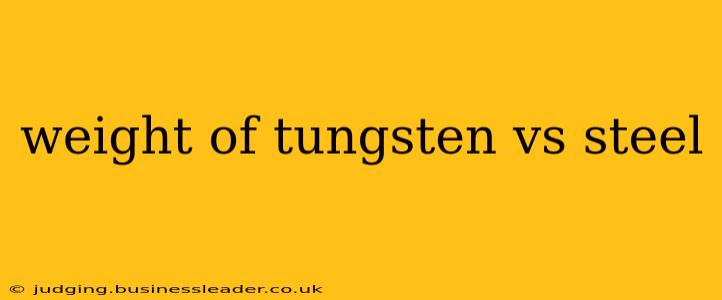Tungsten and steel are both incredibly strong and durable metals, frequently used in demanding applications. However, they differ significantly in density, leading to substantial differences in weight for the same volume. Understanding these weight differences is crucial for engineers, designers, and anyone working with these materials. This article will delve into the specifics of tungsten's and steel's weight, exploring their properties and applications.
What is the density of tungsten and steel?
The key to understanding the weight difference lies in density. Density is mass per unit volume, typically measured in grams per cubic centimeter (g/cm³) or pounds per cubic inch (lbs/in³). Tungsten boasts an exceptionally high density, approximately 19.3 g/cm³, making it one of the densest naturally occurring elements. Steel, on the other hand, has a much lower density, ranging from 7.7 to 8.0 g/cm³ depending on its alloying composition. This density difference is the primary reason why tungsten is considerably heavier than steel for a given volume.
How much heavier is tungsten than steel?
Given the density difference, tungsten is roughly 2.4 to 2.5 times heavier than steel for the same volume. This means a tungsten object of a specific size will weigh approximately 2.4 to 2.5 times more than an identical steel object. This weight disparity has profound implications for various applications.
What are the applications of tungsten and steel?
The significant weight difference between tungsten and steel dictates their respective applications:
-
Tungsten: Its high density makes tungsten ideal for applications requiring high mass in a compact space. This includes:
- Military applications: Kinetic energy penetrators, counterweights.
- Medical applications: Radiation shielding.
- Industrial applications: Weights for fishing, counterbalances.
- Sporting goods: Some types of golf club heads.
-
Steel: Steel’s lower density, coupled with its strength and versatility, makes it suitable for a vast array of applications, including:
- Construction: Buildings, bridges, and infrastructure.
- Automotive: Car bodies, engine components.
- Manufacturing: Machinery, tools, and equipment.
- Household goods: Appliances, cutlery.
What are the advantages and disadvantages of using tungsten vs. steel?
Tungsten Advantages:
- High density: Excellent for applications needing high mass concentration.
- High melting point: Exceptional resistance to high temperatures.
- High strength: Maintains structural integrity under extreme conditions.
Tungsten Disadvantages:
- High cost: Significantly more expensive than steel.
- Brittleness: More prone to fracturing than steel.
- Difficult to machine: Requires specialized tools and techniques for shaping.
Steel Advantages:
- Lower cost: Relatively inexpensive and readily available.
- High tensile strength: Excellent for structural applications.
- Ductility: Can be easily shaped and formed.
- Wide range of alloys: Offers diverse properties depending on alloy composition.
Steel Disadvantages:
- Lower density: Not ideal for applications requiring high mass in a small volume.
- Susceptibility to corrosion: Requires protective coatings or treatments in certain environments.
Is tungsten stronger than steel?
While tungsten has a significantly higher density and melting point, it isn't necessarily "stronger" than steel in terms of tensile strength. The strength of a metal depends on its alloying composition and processing. Certain steel alloys boast exceptional tensile strength, rivaling or even exceeding some tungsten alloys. The comparison is complex and depends on the specific alloy of each metal being considered.
Why is tungsten so heavy?
Tungsten's exceptional heaviness stems directly from its atomic structure. Tungsten atoms are very dense, packing a large amount of mass into a small space. This inherent atomic density translates to a remarkably high density for the material as a whole.
This comparison highlights the crucial differences between tungsten and steel, demonstrating that the choice between these two metals ultimately depends on the specific requirements of the application. Understanding their weight disparities and individual properties is key to making informed decisions in engineering and design.
